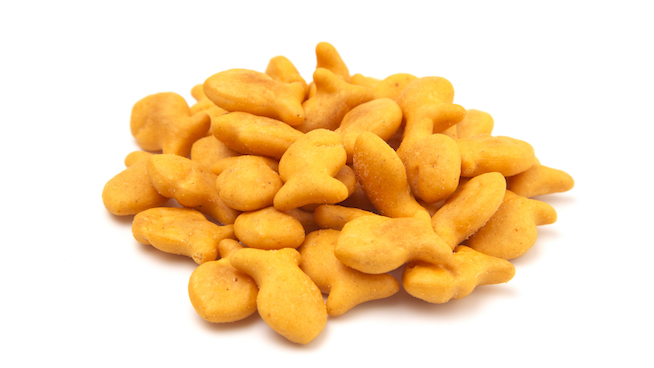Are Goldfish Healthy?
Goldfish are as American as apple pie.
Introduced by Pepperidge Farm in 1962, the fish-shaped cheese crackers have stood the test of time. Perhaps in part due to their enduring nature, Goldfish Crackers have earned a reputation as a reasonably healthy snack. The packaging, which includes phrases like “Baked With 100% Real Cheese” and “No Artificial Flavors or Preservatives,” furthers that impression. But just how healthy are Goldfish, really? Let’s take a closer look at their nutrition facts to deliver a verdict on this longtime lunchbox staple.

Let’s start by focusing on Goldfish Cheddar Baked Snack Crackers, the company’s most popular variety.
One serving (which is about 55 individual crackers) contains:
- 140 calories
- 5 grams of fat
- 1 gram of saturated fat
- 250mg sodium
- 20 grams total carbohydrate
- 1 gram of dietary fiber
- 3 grams of protein
At a glance, these nutrition facts look fairly solid. The 5 grams of fat looks a bit concerning at first glance, but just 1 gram of that qualifies as saturated fat (about half of it is monounsaturated fat, as cheddar cheese is a good source of it). 140 calories per serving seems fine, and no added sugar is a definite plus. These basic facts make Goldfish a far better pick than any of our 21 Horrible Snacks for Athletes.
However, just because Goldfish are better than the junkiest junk food doesn’t mean they’re healthy. Their relative lack of fiber is perhaps my biggest concern. A snack that’s high in fiber and/or high in protein has numerous advantages over a snack that is not.
Fiber helps break down foods for easier digestion, maintains good bowel health, lowers cholesterol levels and helps you feel fuller longer. High-fiber diets have been linked to positive outcomes such as a reduced risk of diabetes, heart disease and obesity. In the short term, snacking on foods high in fiber keeps you fuller for longer and helps you avoid crashing. In the long term, it reduces your risk of many major diseases, supports good bowel health, and can help you achieve/maintain a healthy weight. The Institute of Medicine recommends 38 grams of fiber per day for men age 50 or younger, and 25 grams per day for women age 50 or younger. If you’re looking for a snack that can keep you fuller for longer, fiber content is critical. At 1 gram of fiber per serving, Goldfish don’t quite fit the bill.
Protein is a critical nutrient for humans and athletes, in particular. High-quality protein provides the amino acids muscles need to repair and rebuild, allowing you to recover from exercise and get stronger over time. The body can also use protein as a source of energy. Perhaps most importantly when it comes to snacking, high-protein foods enhance fullness and prevent overeating. Three grams per serving isn’t bad, but it’s not quite enough to be a definitive “plus” for Goldfish.
Like most crackers, Goldfish are also quite light and airy. A cup of sliced banana weighs nearly five times as much as a serving of Goldfish, yet contains 35 fewer calories and two more grams of fiber. When it comes to satiety, the weight of your food matters.
Research has found that the average person eats between 3 and 5 pounds of food per day. In a pamphlet entitled Low-Energy-Dense Foods and Weight Management: Cutting Calories While Controlling Hunger, the CDC writes, “Research shows that people eat a fairly consistent amount of food on a day-to-day basis. This finding holds true whether the amount of food contains many or few calories.”
“That’s the level of food people eat,” says Ryan Andrews, nutrition coach at Precision Nutrition. “Whether it’s 3 to 5 pounds of cheese and candy or 3 to 5 pounds of vegetables and fruits. It’s an important factor to feeling satisfied throughout the day.” To consume 3 pounds worth of Goldfish Crackers, you’d have to eat about 43.6 servings, or 6,104 calories worth.
When you consider such factors, it’s tough to qualify Goldfish as “healthy.” Are they healthier than a lot of similar snacks (chips, crackers, etc.)? Certainly. But they still can’t quite measure up to options like a piece of whole fruit, a serving of Greek yogurt with mixed nuts, or a slice of avocado toast.
However, the Baked with Whole Grain Goldfish Cheddar Snack Crackers contain an extra gram of fiber per serving, while the Made with Organic Wheat Goldfish Cheddar Snack Crackers contain an extra gram of protein per serving. Both are notable improvements on the original recipe, though I’d probably give the whole grain option the nutritional edge due to their superior fiber content. On the flip side, the Flavor Blasted and Goldfish Grahams varieties are generally less healthy than the standard varieties.
Generally speaking, Goldfish Crackers are healthier than most other crackers, chips and similar snacks. But they’re still little more than empty calories, and they’re not gonna put much of a dent in your appetite. In fact, they may only make you hungrier due to their sizable amount of sodium. So it’s probably best to treat Goldfish as an “upgrade” over your usual snack indulgences rather than a staple of your diet.
Photo Credit: pamela_d_mcadams/iStock
READ MORE:
RECOMMENDED FOR YOU
Are Goldfish Healthy?
Goldfish are as American as apple pie.
Introduced by Pepperidge Farm in 1962, the fish-shaped cheese crackers have stood the test of time. Perhaps in part due to their enduring nature, Goldfish Crackers have earned a reputation as a reasonably healthy snack. The packaging, which includes phrases like “Baked With 100% Real Cheese” and “No Artificial Flavors or Preservatives,” furthers that impression. But just how healthy are Goldfish, really? Let’s take a closer look at their nutrition facts to deliver a verdict on this longtime lunchbox staple.

Let’s start by focusing on Goldfish Cheddar Baked Snack Crackers, the company’s most popular variety.
One serving (which is about 55 individual crackers) contains:
- 140 calories
- 5 grams of fat
- 1 gram of saturated fat
- 250mg sodium
- 20 grams total carbohydrate
- 1 gram of dietary fiber
- 3 grams of protein
At a glance, these nutrition facts look fairly solid. The 5 grams of fat looks a bit concerning at first glance, but just 1 gram of that qualifies as saturated fat (about half of it is monounsaturated fat, as cheddar cheese is a good source of it). 140 calories per serving seems fine, and no added sugar is a definite plus. These basic facts make Goldfish a far better pick than any of our 21 Horrible Snacks for Athletes.
However, just because Goldfish are better than the junkiest junk food doesn’t mean they’re healthy. Their relative lack of fiber is perhaps my biggest concern. A snack that’s high in fiber and/or high in protein has numerous advantages over a snack that is not.
Fiber helps break down foods for easier digestion, maintains good bowel health, lowers cholesterol levels and helps you feel fuller longer. High-fiber diets have been linked to positive outcomes such as a reduced risk of diabetes, heart disease and obesity. In the short term, snacking on foods high in fiber keeps you fuller for longer and helps you avoid crashing. In the long term, it reduces your risk of many major diseases, supports good bowel health, and can help you achieve/maintain a healthy weight. The Institute of Medicine recommends 38 grams of fiber per day for men age 50 or younger, and 25 grams per day for women age 50 or younger. If you’re looking for a snack that can keep you fuller for longer, fiber content is critical. At 1 gram of fiber per serving, Goldfish don’t quite fit the bill.
Protein is a critical nutrient for humans and athletes, in particular. High-quality protein provides the amino acids muscles need to repair and rebuild, allowing you to recover from exercise and get stronger over time. The body can also use protein as a source of energy. Perhaps most importantly when it comes to snacking, high-protein foods enhance fullness and prevent overeating. Three grams per serving isn’t bad, but it’s not quite enough to be a definitive “plus” for Goldfish.
Like most crackers, Goldfish are also quite light and airy. A cup of sliced banana weighs nearly five times as much as a serving of Goldfish, yet contains 35 fewer calories and two more grams of fiber. When it comes to satiety, the weight of your food matters.
Research has found that the average person eats between 3 and 5 pounds of food per day. In a pamphlet entitled Low-Energy-Dense Foods and Weight Management: Cutting Calories While Controlling Hunger, the CDC writes, “Research shows that people eat a fairly consistent amount of food on a day-to-day basis. This finding holds true whether the amount of food contains many or few calories.”
“That’s the level of food people eat,” says Ryan Andrews, nutrition coach at Precision Nutrition. “Whether it’s 3 to 5 pounds of cheese and candy or 3 to 5 pounds of vegetables and fruits. It’s an important factor to feeling satisfied throughout the day.” To consume 3 pounds worth of Goldfish Crackers, you’d have to eat about 43.6 servings, or 6,104 calories worth.
When you consider such factors, it’s tough to qualify Goldfish as “healthy.” Are they healthier than a lot of similar snacks (chips, crackers, etc.)? Certainly. But they still can’t quite measure up to options like a piece of whole fruit, a serving of Greek yogurt with mixed nuts, or a slice of avocado toast.
However, the Baked with Whole Grain Goldfish Cheddar Snack Crackers contain an extra gram of fiber per serving, while the Made with Organic Wheat Goldfish Cheddar Snack Crackers contain an extra gram of protein per serving. Both are notable improvements on the original recipe, though I’d probably give the whole grain option the nutritional edge due to their superior fiber content. On the flip side, the Flavor Blasted and Goldfish Grahams varieties are generally less healthy than the standard varieties.
Generally speaking, Goldfish Crackers are healthier than most other crackers, chips and similar snacks. But they’re still little more than empty calories, and they’re not gonna put much of a dent in your appetite. In fact, they may only make you hungrier due to their sizable amount of sodium. So it’s probably best to treat Goldfish as an “upgrade” over your usual snack indulgences rather than a staple of your diet.
Photo Credit: pamela_d_mcadams/iStock
READ MORE:










